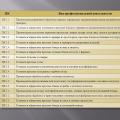Filling out the directory of outlets. Outlet classification: Italian and Russian systems. Principles for the classification of retail outlets. Peculiarities of working with outlets of different types Classification of outlets by category
Outlets. What are they?
Posted date: 2011-05-17
Outlets is the basis and the pledge successful activities sales representative. So what are they like, these outlets? White, blue, red and pearl buttons?
Black outlets(or sometimes they say gray outlets).
In the language of trade they say about such - the point works "in black".
They are characterized by the fact that they do not require from the supplier, in this case from you, contracts, invoices, etc. They only need a sales receipt (bill of lading) upon delivery. As a rule, they pay for the delivery immediately, i.e. upon shipment. It is very dangerous to leave goods for a delay at such a point of sale, unless you are on very good terms with its owner and completely trust him. When such a point is connected (at the first delivery of the goods), only the name, actual address, telephone number of the contact person are needed from it.
Things are much more confused with white outlets.
Accordingly, about such points they say "the point works in white."
It is obligatory to conclude a supply contract. When concluding a contract, you must take the details of the outlet. Normal points have customer cards (the A4 sheet contains all the necessary details). These include at least: TIN, KPP, PSRN, legal and actual address of the point, full name of the gene. Directors, bank details (current account, correspondent account, BIK bank, name of the bank or its branch), contact phones. This data is enough to add a new white outlet to the company's database, which works “in fact”.
When granting a deferred payment for cash or payment for deliveries on cashless payments require additional documents from the outlet. The bigger, the better. These may include the charter (if it is not an individual entrepreneur), a lease agreement for premises for trade, an order on the appointment of a gene. Directors, etc. I repeat once again - the more information you collect about the outlet, the safer it will be to start cooperating with them.
When delivering goods to a white retail outlet, which works according to the cash / fact (or cash / deferred) scheme, the following documentation is provided along with the delivery: consignment note, invoice, cashier's check(sometimes the check is knocked out after entering Money to the cashier and taken to the merchant at the next visit to the outlet), quality certificates for the supplied products, certificates (approximately once a year), veterinary certificates (at the request of the outlet).
When delivering goods to a retail outlet that pays for the goods by bank transfer - all the same documents, with the exception of the cash register receipt.
TYPES OF SALES.
| Parameter name | Meaning |
| Topic of the article: | TYPES OF SALES. |
| Rubric (thematic category) | Marketing |
III. OUTLETS.
FOUR PRINCIPLES OF MERCHANDISING.
1. Exposition. The products are clearly visible to the buyer.
2. Impact. The product looks good and convinces in the purchase.
3. Price presentation. The buyer must understand the benefits of the purchase.
4. Convenience. You can take the products with your hands.
Merchandising for a manufacturer is
the last chance to show the product to the buyer; the ability to influence the choice of the buyer; a way to nudge him to buy more units.
Merchandising for retail retail - every retail outlet is interested in creating effective stock goods and present them to buyers in the hall in the best possible way.
Merchandising for a point of sale is an opportunity to maximize income per unit of shelf space; the opportunity to increase the number of regular customers; a way to improve the efficiency of staff trading floor.
Cash and carry. CASH-AND-CARRY. Trading area: 1000 m 2 or more. Service mode: self-service. Consumer Behavior: Buyers visit on a planned basis, the goal is to buy food in small wholesale. Behavior of competitors: the main assortment of almost all manufacturers.
Hypermarkets. Sales area: 1000 m 2 and more. Service mode: self-service. The size of the main point of sale: more than 15 meters. Consumer Behavior: Buyers visit on a planned basis, the goal is to buy products for a long time or for every day. Competitor behavior: a full range of almost all manufacturers.
Supermarkets. Sales area: 300-1000 m 2. Service mode: self-service. The size of the main point of sale: 5-15 meters. Consumer Behavior: Buyers visit on a planned and impulsive basis, the goal is to buy products for a long time or for every day. Competitor behavior: the main assortment of most manufacturers.
Minimarkets. Sales area: 50-300 m 2. Service mode: self-service. The size of the main point of sale: up to 5 meters. Consumer Behavior: Buyers visit on a planned and impulsive basis, the goal is to buy goods for every day. Competitor behavior: the main assortment of the most famous brands.
Discounters. Sales area:> 300 m 2. Service mode: self-service. The size of the main point of sale: 7-10 meters. Consumer Behavior: Shoppers visit on a planned and impulsive basis, the goal is to buy products for a long time and every day. Competitor behavior: main range of well-known brands.
Shops with trade through the counter. Sales area: 50-300 m 2. Service mode: no self-service. The size of the main point of sale: up to 3 meters. Consumer Behavior: Buyers visit on a planned and impulsive basis, the goal is to buy goods for every day. Competitor Behavior: Top Selling Positions of Famous Brands.
TYPES OF SALES. - concept and types. Classification and features of the category "TYPES OF SALES." 2017, 2018.
Trade Marketing
Trade marketing channels of influence. Principles and strategies for building an effective sales channel management system.
TM channels of influence include all places where your products are sold (wholesale or retail) or could be sold. Channels can be divided into distribution, wholesale, retail, corporate and non-recurring.
To the distribution channel refers to companies that directly purchase goods from one or more manufacturers. The manufacturer can sell goods both only through distributors, and in parallel through a retail, corporate and irregular channel.
To the wholesale channel y refers to companies that purchase goods from distributors and sell them to other wholesalers as well as to retail and corporate clients. The main criterion that distinguishes a wholesaler from a distributor is that the wholesaler does not purchase goods directly from the manufacturer.
To the retail channel includes all companies that sell goods to the final consumer. This channel also includes online stores.
To the corporate channel include companies that purchase goods from manufacturers, distributors, wholesalers, as well as retail to meet their needs.
To the irregular channel includes companies making one-time purchases in one of the other channels listed above. An irregular channel is often combined with a corporate one.
Principles and strategies for building an effective sales channel management system.
1. assignment of a person responsible for the channel management function (such a person can be a marketing director, Commercial Director, Director of Sales);
2. determination of the performer or performers implementing the channel management function (performers can be the head of the marketing department, the head of the sales department, the trade marketing manager;
3.conducting a full audit of relationships with partners (distributors, dealers, corporate clients etc.), as well as a study of existing commodity distribution routes of supplied products and identification of key players in each channel in priority regions;
4. Development of a strategy and tactics for managing sales channels by forming an optimal matrix of distribution channels at the current moment, as well as in the near and long term;
5. translation of the sales channel management strategy into specific targets for each channel / matrix position;
6. development of the plan marketing communications for the next period (a year or six months) to penetrate the dedicated sales and development channels of existing ones;
7. preparation of a complete set of marketing materials (presentations, brochures, commercial offers, product display standards, etc.) required to implement the approved channel management strategy;
8. Development and implementation of a system of internal rules for all employees involved in the implementation commercial function(marketing department, sales department, purchasing department, logistics department, warehouse complex, transport service), to support the created sales channel management system;
9.development detailed plan implementation of the channel management strategy and the actual launch of the implementation.
Levers and tools for influencing various objects of trade marketing. The concepts of bonuses, discounts, retro bonuses.
Levers and tools TM for buyers:
Display of goods on the shelves;
Seasonal and planned sales;
Demonstration and presentation of goods in stores;
Buyer bonuses;
Contests, lotteries and games for buyers;
The presence of a consultant at the point of sale;
Special events for sales staff and resellers:
Exhibitions of a specific specialization;
Presentations;
Samples for sales staff and product demonstration;
Trainings;
Conferences and seminars;
Diplomas and certificates.
The concepts of bonuses, discounts, retro bonuses.
Sell-in. Discounts for wholesalers and retailers:
With the agreed individual conditions;
With a one-time purchase;
Upon reaching the set plan;
Off-season / seasonal;
In the form of incentives for the sale of a new product;
With a complex purchase.
Sell-out. Sales link bonuses:
For each item of goods;
Upon completion of an individual plan;
-% of sales volume;
With an increase in distribution;
Lottery;
Team bonus;
Concepts of POS-materials and trade equipment. Types of POS materials. Features and principles of developing POS materials.
POS materials (decoration of points of sale, advertising of products that works at points of sale: wobblers, shelf talkers, price tags, stoppers, posters, tags, calendars, key rings, and any other souvenir items with product logos) that inform the buyer about the product and serve to attract his attention. Buyers, studying POS materials, receive information about the benefits of products. Thus, due to the information content and the ability to draw attention to the product, POS materials stimulate sales. Skillfully planning advertising campaign, even with a modest budget, you can successfully promote your product at points of sale.
Types of POS materials
1. Materials in the outdoor area.
2.in the entrance group
3.in the trading floor
4.in the place of display
5. in the checkout area.
Development of POS materials:
1. The ratio of efficiency.
2. The ratio of the budget, the number of outlets and units of material.
3. The ability to hold attention, its readability (of the material), large letters, max words, one picture.
4. Originality.
Commercial equipment is the face of any store and the choice of commercial furniture should be approached with great care. TO trade equipment include:
Refrigerators, racks, racks, promotional stands, floor stickers, dispensers above cash registers, package displays in the center of the hall, branded package tape, branded box for small products, croutons tape, video displays, flags, ashtray, matches, glasses, cups, mirrors, elements decor, tables, chairs, umbrellas, etc.
Outlet classification: Italian and Russian system... Principles for the classification of retail outlets. Features of working with retail outlets different types.
We must clearly understand who our customers are among the stores.
Italian classification:
1) Superstore is a huge store. More than 20 thousand square meters Food more than 50% (we have a Marktkauf hypermarket). Different pricing policy.
2) Hypermarket-Hyperstor (Auchan) from 4-10 thousand sq. M. Food 70%. They are located outside the cities. Uniform pricing policy for all categories of goods.
3) Supermarket (at the intersection of passenger traffic, location is important). From 500-2 thousand sq. M. Crossroads, 7th continent.
4) Superretto deli up to 500 sq.m. Food up to 90%. Consumer goods.
5) Discounters (special structure inside the store, large functional shelving, minimum staff, etc.)
6) Small narrowly specialized shops from 60-80sq.m. Meat, vegetables, bread.
Russian classification:
1) Hypermarket over 1000 sq.m. Up to 80 thousand SKU, outside the cities. One-stop-shopping-hypermarket concept, low price policy, especially popular and seasonal goods. We almost always have our own products. They prefer to buy not from distributors, but from manufacturers through a distribution center. Unified assortment matrix.
2) Supermarket (self-service store), from 300-3 thousand sq. M. In sleeping areas, more often near the metro, there are more than two ticket offices, products of daily demand. They are actively working with distributors and manufacturers.
3) Supermarket-grocery store less than 300sq.m. Sales through the counter and vendors by section, food and household goods. Pricing policy is different. Chaotic direction.
4) Traditional shops from 50 to 300 sq.m. Household. or food. The margin is not very good, they work through distributors, and not with manufacturers, a good place for experimenting with a new product.
5) Pavilions up to 20 sq.m. Sales through the window counter.
6) Kiosks-tents (scattered) without a sales area with a small area.
Customer service format:
-Store shops
-Self-service stores
TYPES OF SALES.
| Parameter name | Meaning |
| Topic of the article: | TYPES OF SALES. |
| Rubric (thematic category) | Marketing |
III. OUTLETS.
FOUR PRINCIPLES OF MERCHANDISING.
1. Exposition. The products are clearly visible to the buyer.
2. Impact. The product looks good and convinces in the purchase.
3. Price presentation. The buyer must understand the benefits of the purchase.
4. Convenience. You can take the products with your hands.
Merchandising for a manufacturer is
the last chance to show the product to the buyer; the ability to influence the choice of the buyer; a way to nudge him to buy more units.
Merchandising for retail retail - every retail outlet is interested in creating an efficient stock of goods and presenting them to customers in the hall in the best possible way.
Merchandising for a point of sale is an opportunity to maximize income per unit of shelf space; the opportunity to increase the number of regular customers; a way to improve the efficiency of the sales floor personnel.
Cash and carry. CASH-AND-CARRY. Sales area: 1000 m 2 and more. Service mode: self-service. Consumer Behavior: Buyers visit on a planned basis, the goal is to buy food in small wholesale. Behavior of competitors: the main assortment of almost all manufacturers.
Hypermarkets. Sales area: 1000 m 2 and more. Service mode: self-service. The size of the main point of sale: more than 15 meters. Consumer Behavior: Buyers visit on a planned basis, the goal is to buy products for a long time or for every day. Competitor behavior: a full range of almost all manufacturers.
Supermarkets. Sales area: 300-1000 m 2. Service mode: self-service. The size of the main point of sale: 5-15 meters. Consumer Behavior: Buyers visit on a planned and impulsive basis, the goal is to buy products for a long time or for every day. Competitor behavior: the main assortment of most manufacturers.
Minimarkets. Sales area: 50-300 m 2. Service mode: self-service. The size of the main point of sale: up to 5 meters. Consumer Behavior: Buyers visit on a planned and impulsive basis, the goal is to buy goods for every day. Competitor behavior: the main assortment of the most famous brands.
Discounters. Sales area:> 300 m 2. Service mode: self-service. The size of the main point of sale: 7-10 meters. Consumer Behavior: Shoppers visit on a planned and impulsive basis, the goal is to buy products for a long time and every day. Competitor behavior: main range of well-known brands.
Shops with trade through the counter. Sales area: 50-300 m 2. Service mode: no self-service. The size of the main point of sale: up to 3 meters. Consumer Behavior: Buyers visit on a planned and impulsive basis, the goal is to buy goods for every day. Competitor Behavior: Top Selling Positions of Famous Brands.
TYPES OF SALES. - concept and types. Classification and features of the category "TYPES OF SALES." 2017, 2018.
 Professions related to mathematics
Professions related to mathematics Report on the topic: Formation of professional competencies of future catering specialists
Report on the topic: Formation of professional competencies of future catering specialists Report on the topic: Formation of professional competencies of future catering specialists
Report on the topic: Formation of professional competencies of future catering specialists